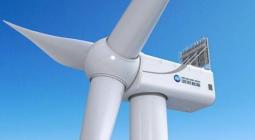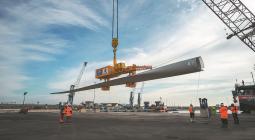‘Chinese offshore wind technology is accelerating – I expect 25MW turbines soon’

OPINION
There's no reason to expect a slowdown in the frenetic pace that has driven China's manufacturers to power ratings well beyond their western peers, writes Shashi Barla
The last two years have seen a frenetic pace of new turbine launches in the Chinese wind industry – and there’s no reason to expect that to stop any time soon.
This rapid pace of technology iteration was driven by the phase-out of offshore wind feed-in tariffs at the end of December 2021, while China’s ’30-60’ carbon goal – carbon peaking by 2030, carbon Neutral by 2060 – also resulted in accelerated offshore wind technology development.
Some of the wind turbines announced by Chinese manufacturers in the past two to three months dwarf western OEMs’ configurations by a huge margin. Players like Mingyang with (MySE18.X-28X, MySE16-260, MySE14-260), CSSC (H260-18.0MW), Envision (EN-252/14MW) and Goldwind (GWH252-16.0MW) to name just a few.
Chinese wind turbine technology evolution is not decelerating yet; I anticipate machines up to 25MW with up to 320-metre rotors to be commercially announced before the end of the China 14th five-year plan (2025) and to be deployed during the 15th five-year plan (2026-2030).
From the first offshore wind demonstration projects in 2008 to the beginning of the grid-parity era in 2022, China installed more than 30GW of offshore wind capacity. Of these, 20-plus gigawatts was installed in the past two years. Demand in this decade is expected to surpass 200GW, reinforcing China’s offshore leadership position.
In 2022 alone, more than 20GW of offshore capacity was tendered (excluding the 10GW of the framework agreement by SPIC), a significant increase compared to a meagre 2.8GW tendered in 2021. This 20GW is expected to be installed over the next two years.
Such an unprecedented demand offers potential for the supply chain to ramp up and explore new technologies. Offshore development plans of 80GW have been announced across various provinces in China. The country is targeting 50GW of offshore capacity by 2025, 200GW by 2030 and 1,000GW by 2050.
Are these giant turbines justified?
The market demand off relatively high-wind provinces like Fujian and Guangdong certainly justifies the trend to larger machines. Guangdong will become the largest demand centre in China in this decade. The seabed conditions are very complex, with rocks and deep waters, while Fujian is also affected by typhoons. Such site characteristics escalate the cost of wind project development. Leveraging larger rated turbines of 14-18MW with moderate rotor sizes of 230-260 metres in the South of Fujian and East of Guangdong will lower the costs and increase energy yield.
However, only some of the provinces in China need these larger-rated turbines. Wind speeds in Shandong and North of Jiangsu are relatively lower, so lower-rated machines with longer rotors will generate higher yields on a per-turbine basis.
This positively impacts project economics. In December 2022 first projects utilising the 8-10MW turbines with rotors up to 230 metres were installed and commissioned. As an example, Bezhong sites A & B were equipped with CSSC H220-8.35MW and Shanghai Electric EW-8.5-230 turbines, respectively, for a nearly 1GW project by Shandong Energy.
Envision is replicating the onshore low-wind product strategy into offshore as well. In 2022, the company secured 2-plus gigawatts of orders for its low wind turbines EN-226/8.5MW (1.5-plus GW) and EN-200/7.0MW (0.5GW). CRRC won its first offshore order in Zhejiang province for its low wind turbine WD225-9000, the construction has already commenced on this project in late 2022.
Imperative behind higher-rated machines
Prior to the FiT phase-out, offshore wind projects received a remuneration of 850 yuan/MWh ($126/MWh). After this scheme ended in December 2021, projects were at grid parity and no additional remuneration besides the regional coal-based power benchmark price was guaranteed.
In order to compete at those price levels, the developers must lower Capex, and increasing turbine sizes is one of the biggest levers for them to sustain project internal rate of returns (IRRs).
As offshore FITs are phased-out, turbine average selling price (ASP) in tenders has plummeted by 45% compared to two years ago (see chart at foot). For a recent 1GW tender in January 2023, offshore turbine pricing bids were ranging 2,353 to 3,550 yuan/kW including the tower. This clearly implies that Chinese offshore turbine pricing is now lower than half of western turbine OEMs’ onshore turbine pricing.
These price levels certainly pave the way for Chinese OEMs into the international markets. However, it will be an uphill battle. So far, Envision, Goldwind, Dongfang, and Windey have secured orders for near-shore projects in Vietnam. These projects use customised onshore turbines, however. Besides these, Mingyang has secured orders in Italy, The UK and Japan. Harbin Electric signed a 5MW floating project in France in December 2022. At the same time, Envision is in discussion for projects in Norway.
Tier One Western developers and utility companies may engage in discussions with Chinese turbine OEMs for commercial projects. Even so, we do not foresee any large-scale deployments in the next five years. However, the developers may use these price points to benchmark against the Western turbine OEMs’ supply chain and may exert pressure on these suppliers to lower the pricing. The price delta between Western turbine OEMs and the Chinese OEMs will diminish if Chinese companies were to establish a supply chain in any of the leading Western offshore markets.
Chinese market fragmenting further
Meanwhile, back in China, despite the national-level offshore wind subsidy phase-out, a few provinces like Guangdong, Shandong and Zhejiang still offer subsidies for projects commissioned between 2022 to 2024. These provinces have become major battlefields for Chinese OEMs. Coastal provinces increased R&D investments for developing larger rated turbines and encouraging manufacturing bases to produce the nacelles and components for such technologies.
In 2023, ten turbine OEMs will compete for a share of the offshore market, three more than a year ago. Chinese offshore turbine supply space will become fierce as new OEMs join the bandwagon. Players like Windey and CRRC secured their first offshore contracts in Q3-2022 for deployment in 2023/24. SANY Renewables is en route to securing its first offshore contract this year.
These companies are joining Shanghai Electric, Envision, Mingyang, Goldwind, CSSC, and Dongfang. The Chinese offshore market is already fragmented compared to Global Excluding China, but increasing demand is prompting new players to seek opportunities.
- Shashi Barla is head of research for renewable energy at Brinckmann





